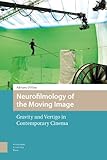Neurofilmology of the Moving Image : Gravity and Vertigo in Contemporary Cinema / Adriano D'Aloia.
Material type: TextPublisher: Amsterdam : Amsterdam University Press, [2021]Copyright date: ©2021Description: 1 online resource (254 p.)Content type:
TextPublisher: Amsterdam : Amsterdam University Press, [2021]Copyright date: ©2021Description: 1 online resource (254 p.)Content type: - 9789048553709
- Motion pictures -- Psychological aspects
- Neurosciences and motion pictures
- AUP Wetenschappelijk
- Amsterdam University Press
- Film Studies
- Film, Media, and Communication
- Interdisciplinary Studies
- Psychology
- PERFORMING ARTS / Film & Video / General
- Embodiment, Film experience, Contemporary cinema, Neurofilmology, Cinematic empathy
- 791.43019 23
- online - DeGruyter
| Item type | Current library | Call number | URL | Status | Notes | Barcode | |
|---|---|---|---|---|---|---|---|
 eBook
eBook
|
Biblioteca "Angelicum" Pont. Univ. S.Tommaso d'Aquino Nuvola online | online - DeGruyter (Browse shelf(Opens below)) | Online access | Not for loan (Accesso limitato) | Accesso per gli utenti autorizzati / Access for authorized users | (dgr)9789048553709 |
Frontmatter -- Table of Contents -- Acknowledgements -- I Vertigo -- II Acrobatics -- III Fall -- IV Impact -- V Overturning -- VI Drift -- VII Flight -- Bibliography -- Filmography -- Index
restricted access online access with authorization star
http://purl.org/coar/access_right/c_16ec
A walk suspended in mid-air, a fall at breakneck speed towards a fatal impact with the ground, an upside-down flip into space, the drift of an astronaut in the void… Analysing a wide range of films, this book brings to light a series of recurrent aesthetic motifs through which contemporary cinema destabilizes and then restores the spectator’s sense of equilibrium. The 'tensive motifs' of acrobatics, fall, impact, overturning, and drift reflect our fears and dreams and offer embodied forms of transcendence of the limits of our human condition along with an awareness of their insurmountable nature. Adopting the approach of 'Neurofilmology'—an interdisciplinary method that puts filmology, perceptual psychology, philosophy of mind, and cognitive neuroscience into dialogue—this book implements the paradigm of embodied cognition in a new ecological epistemology of the moving-image experience.
Mode of access: Internet via World Wide Web.
In English.
Description based on online resource; title from PDF title page (publisher's Web site, viewed 25. Jun 2024)


